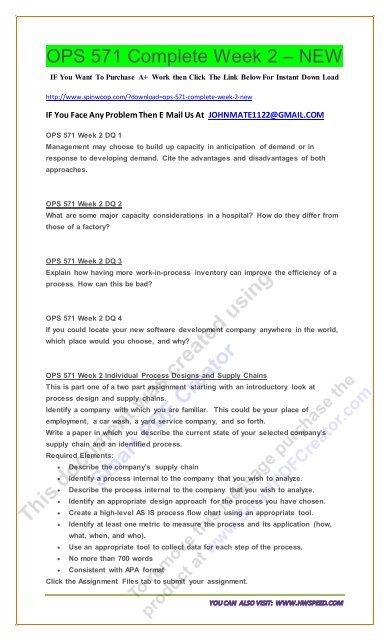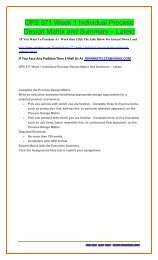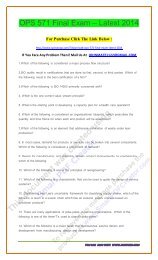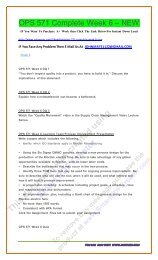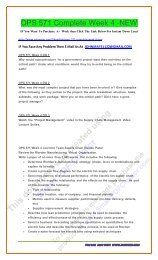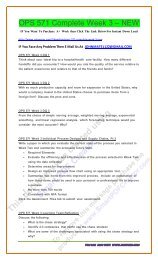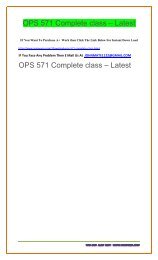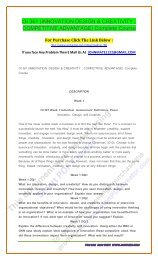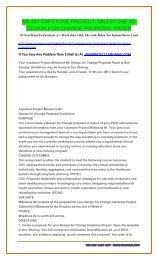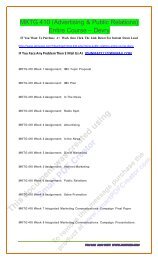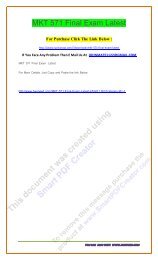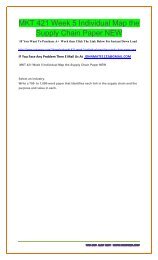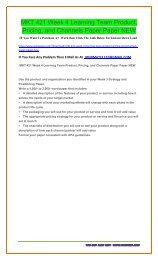OPS 571 Complete Week 2 – NEW
You also want an ePaper? Increase the reach of your titles
YUMPU automatically turns print PDFs into web optimized ePapers that Google loves.
<strong>OPS</strong> <strong>571</strong> <strong>Complete</strong> <strong>Week</strong> 2 <strong>–</strong> <strong>NEW</strong><br />
IF You Want To Purchase A+ Work then Click The Link Below For Instant Down Load<br />
http://www.spinwoop.com/?download=ops-<strong>571</strong>-complete-week-2-new<br />
IF You Face Any Problem Then E Mail Us At JOHNMATE1122@GMAIL.COM<br />
<strong>OPS</strong> <strong>571</strong> <strong>Week</strong> 2 DQ 1<br />
Management may choose to build up capacity in anticipation of demand or in<br />
response to developing demand. Cite the advantages and disadvantages of both<br />
approaches.<br />
<strong>OPS</strong> <strong>571</strong> <strong>Week</strong> 2 DQ 2<br />
What are some major capacity considerations in a hospital? How do they differ from<br />
those of a factory?<br />
<strong>OPS</strong> <strong>571</strong> <strong>Week</strong> 2 DQ 3<br />
Explain how having more work-in-process inventory can improve the efficiency of a<br />
process. How can this be bad?<br />
<strong>OPS</strong> <strong>571</strong> <strong>Week</strong> 2 DQ 4<br />
If you could locate your new software development company anywhere in the world,<br />
which place would you choose, and why?<br />
<strong>OPS</strong> <strong>571</strong> <strong>Week</strong> 2 Individual Process Designs and Supply Chains<br />
This is part one of a two part assignment starting with an introductory look at<br />
process design and supply chains.<br />
Identify a company with which you are familiar. This could be your place of<br />
employment, a car wash, a yard service company, and so forth.<br />
Write a paper in which you describe the current state of your selected company’s<br />
supply chain and an identified process.<br />
Required Elements:<br />
Describe the company’s supply chain<br />
Identify a process internal to the company that you wish to analyze.<br />
Describe the process internal to the company that you wish to analyze.<br />
Identify an appropriate design approach for the process you have chosen.<br />
Create a high-level AS IS process flow chart using an appropriate tool.<br />
Identify at least one metric to measure the process and its application (how,<br />
what, when, and who).<br />
Use an appropriate tool to collect data for each step of the process.<br />
No more than 700 words<br />
Consistent with APA format<br />
Click the Assignment Files tab to submit your assignment.
<strong>OPS</strong> <strong>571</strong> <strong>Week</strong> 2 Learning Team Reflection<br />
Select a manufacturing organization the team members are familiar with.<br />
Review the company’s website and other available information and answer the<br />
following:<br />
What type of process design do they use: Make to Order, Make to Stock, or<br />
Batch?<br />
What are two items regarding the manufacturing process related to the<br />
organization that the team finds unique or interesting?<br />
Prepare a 350- to 1,050-word paper detailing the findings of your discussion.<br />
Click the Assignment Files tab to submit your assignment.<br />
<strong>OPS</strong> <strong>571</strong> <strong>Week</strong> 2 Quiz<br />
1.) In the pull system, which of the following is the partner that begins the process of<br />
pulling?<br />
Vendors<br />
Quality control personnel<br />
Customers<br />
Executive management<br />
2.) Which of the following operations consulting tools are used in the cost impact<br />
and payoff analysis stage in the operations consulting process?<br />
SPC tools and bottleneck analysis<br />
Customer surveys and gap analysis<br />
Decision trees and stakeholder analysis<br />
Plant audits and statistical tools<br />
3.) Which of the following production process terms best describes a stage in a<br />
multiple-stage process that limits the capacity of the overall process?<br />
Buffer<br />
Starving<br />
Bottleneck<br />
Blocking<br />
4.) Which of the following is a principle of reengineering?<br />
Organize around the tasks<br />
Capture information many times, at the source and where it is interpreted<br />
Treat geographically dispersed resources as though they were centralized<br />
Integrate the outcomes of parallel activities
5.) Which of the following operations consulting tools provide summary performance<br />
updates for specific processes and are generally presented in graphical form with<br />
color-coding of trend lines and alarms?<br />
Decision trees<br />
Stakeholder analysis<br />
Process dashboards<br />
Responsibility charts<br />
6.) Which of the following are possible examples of cycle times?<br />
Time that a part waits in queue<br />
Time it takes for an instructor to grade an exam<br />
Time required to produce a batch of parts<br />
Time to set up a new assembly line<br />
7.) What is the term that refers to “the fundamental rethinking and radical redesign of<br />
business processes to achieve dramatic improvements in critical, contemporary<br />
measures of performance, such as cost, quality, service, and speed” (as cited in<br />
Jacobs & Chase, 2011, p. 461).<br />
Reengineering<br />
TQM<br />
Operations consulting process<br />
Continuous improvement<br />
8.) Which of the following is a key metric associated with value stream mapping?<br />
Defects per million operations<br />
Lead time<br />
Product demand<br />
Fixed costs<br />
9.) Which of the following is one of the major types of stakeholders impacted by most<br />
consulting projects?<br />
Board of directors<br />
International government regulators<br />
Suppliers<br />
Other consultants<br />
10.) Lean production seeks to achieve high volume production using which of the<br />
following?<br />
Minimize utilization<br />
Minimize inventory of raw materials
Maximize inventory of work-in-process<br />
Maximize capacity<br />
11.) In contrast to TQM, what approach seeks radical change through innovation?<br />
JIT distribution<br />
Project management<br />
Reengineering<br />
Lean manufacturing<br />
12.) In setting up a kanban control system, you need to determine the number of<br />
kanban card sets needed. If the average number of units demanded is 1,000 per hour,<br />
the lead time to replenish the order for this item is 10 hours, the container size is 5<br />
units, and the safety stock is estimated to be 5% of the expected demand, what is the<br />
number of kanban card sets needed?<br />
210<br />
440<br />
1,050<br />
2,100<br />
13.) Which of the following is a situation that likely will yield economies of scale?<br />
Large factory with dedicated capacity that is able to produce twice the number of<br />
units as locally demanded<br />
Factory that fully utilizes dedicated resources for information technology, material<br />
handling, and administrative support<br />
Company with factories in multiple countries that produces products for local<br />
demand<br />
Factory that produces low volume, customized products<br />
14.) The basic notion of economies of scale assumes which of the following?<br />
A piece of equipment with twice the capacity of another piece typically costs twice as<br />
much to purchase and to operate<br />
Total cost of output drops as volume increases<br />
Average cost per unit of output drops as a plant gets larger and volume increases<br />
Two plants can be operated at the same cost as a single plant<br />
15.) To implement a flow process in developing a lean system, a firm might do which<br />
of the following?<br />
Reduce setup/changeover time<br />
Eliminate some fixed costs<br />
Improve capacity utilization<br />
Build product in anticipation of demand
16.) An advantage of a make-to-stock process is which of the following?<br />
All units of output are unique<br />
Rapid delivery of a standard product<br />
It responds directly to customer orders<br />
It allows the firm to avoid inventory costs<br />
17.) According to Little’s law, which of the following can be used to estimate<br />
inventory?<br />
Set up time times throughput rate<br />
Process velocity times flow time<br />
Process time times cycle time<br />
Throughput rate times flow time<br />
18.) Which of the following is a factor that causes a diseconomy of scale?<br />
Increased utilization<br />
Increased transportation costs<br />
Increased total operating costs<br />
Increased product value and prices<br />
19.) If the run time for a batch of parts is 25 minutes on a machine, and the setup time<br />
is 75 minutes, which of the following is the operation time?<br />
3 minutes<br />
25 minutes<br />
100 minutes<br />
75 minutes<br />
20.) Which of the following production process terms best describes the situation<br />
when activities in a stage of production must stop because there is no work?<br />
Multiple-stage processing<br />
Starving<br />
Blocking<br />
Buffering<br />
21.) Which of the following terms refers to a special type of flowcharting tool that is<br />
valuable for the development of lean processes?<br />
Kanban production control system<br />
JIT production<br />
Value stream mapping<br />
Kaizen


